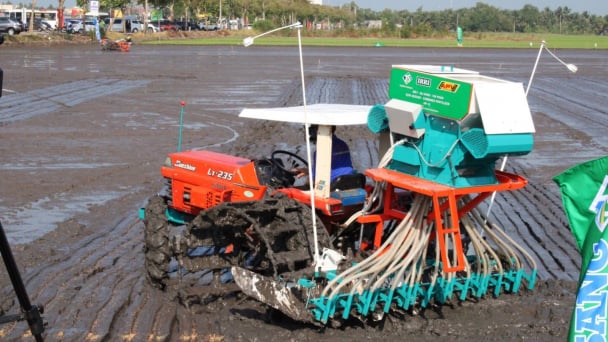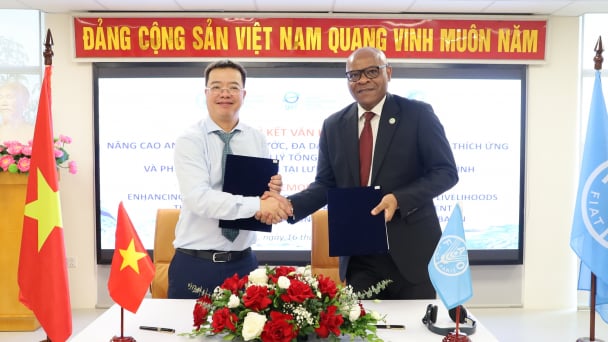May 21, 2025 | 03:23 GMT +7
May 21, 2025 | 03:23 GMT +7
Hotline: 0913.378.918
May 21, 2025 | 03:23 GMT +7
Hotline: 0913.378.918
After four years of trial planting macadamia trees in Quynh Nhai district (Son La) through agroforestry, it has been confirmed that the macadamia tree is a multipurpose species that provides significant advantages in terms of socioeconomic and environmental aspects. It has the potential to become a novel tree that contributes to the enhancement of domestic and international production and export value.

Currently, some experimental macadamia orchards have initially produced positive output, showing many prospects for development in Quynh Nhai district. Photo: Nguyen Thieu.
With its rapid growth rate and fruit production, the tree variety has the potential to become the staple tree for poverty reduction, hunger eradication, and economic development in Quynh Nhai district and Son La province.
The geography of the Quynh Nhai area is varied, resulting in several sub-climates that provide excellent circumstances for the production of fruit trees and seed trees ranging from temperate to tropical species, including macadamia trees. To carry out Son La province's objective of growing macadamia nuts by 2025 and extending it to 2030, the Provincial People's Committee authorized Lien Viet Son La Joint Stock Company to invest in planting and cultivating macadamia trees on a big scale of over 161.2ha in Quynh Nhai district.
Since 2018, the project has extended to 62.8 ha of 1,700 macadamia trees in Muong Chien commune, including seven types, including QN1, A38, 800, 246, 849, 816, and 842 at a density of 280 trees per ha.
Macadamia trees are grown organically, using advanced science and technology. In 2021, around 5% of trees produced blooms, and some bore the first batches of fruits. Additionally, the 2020 freshly expanding orchard has developed grade II branches and is in the process of creating grade III branches.

Macadamia is a multi-purpose tree, in line with the orientation of agricultural development in Son La province. Photo: Nguyen Thieu.
The planting area will continue to expand in the future years. According to Mr. Duong Van Dat, Chairman of the Board of Directors and Director of Lien Viet Son La Joint Stock Company, macadamia is resistant to frost and drought, has few pests and diseases, and an intercrop and shade with a wide variety of other plant varieties such as tea, coffee, and short-term agricultural crops. As a result, macadamia may be developed in a variety of ways, either as a single species or as an intercrop. Currently, the company's macadamia tree model is providing stable employment for a number of local residents.
Mr. Lo Van Giang, a resident of Bon village in Muong Chien commune (Quynh Nhai district), explained that since the firm brought the macadamia tree to plant in Muong Chien commune, he and other residents have been recruited and now have a stable source of income.
Mr. Tong Van Cau's household in Pieng Bay village, Chieng Khay commune, was one of the first to engage in macadamia tree cultivation through the Lien Viet Son La enterprise. Previously, four hectares of hill land were utilized to cultivate corn and cassava. With technical help from the firm on how to care for seedlings, his family has converted into a trial area for macadamia tree planting.

Currently, many people in Quynh Nhai district have boldly covert lands to grow low-value food crops such as corn and cassava into grow macadamia. Photo: Nguyen Thieu.
Until now, his family's macadamia tree plantation has grown and developed successfully as a result of his active study and use of scientific and technical developments. He stated that whenever a product is available, Lien Viet Son La Company will advocate its use and purchasing.
Lien Viet Son La Company stated that it has been the purchaser of macadamia products for many years for farmers in Son La province. Macadamia nuts with split shells, macadamia kernels, macadamia wine, and macadamia oil are among the company's products.
The product has been approved as a typical rural industrial product at the province level by the Son La Provincial People's Committee and is available at safe food shops, supermarket chains in Hanoi, and distributors in Son La city, Mai Son district, and Moc Chau district.
Mr. Duong Van Dat, Chairman of the Board of Directors and Director of Lien Viet Son La Joint Stock Company, explained that the province has some macadamia trees that have been developed and produced consistently since 2015.
Additionally, Son La province organized a working group to evaluate piloting macadamia gardens and found that these gardens are now yielding reasonably reliable harvests with comparatively high profits in comparison to the fruit trees currently planted in Son La.
The district of Quynh Nhai now has 118ha of macadamia, the majority of which is concentrated in the communes of Chieng Khay, Chieng On, Chieng Khoan, and Muong Sai, where the tree flourishes. There is just one hectare of pilot macadamia planting in the district, which produces around 1.6 quintals per hectare.

Some macadamia orchards are mechanized by farmers. Photo: Nguyen Thieu.
The district authority of Quynh Nhai has been proactive in instructing specialized offices and departments to work with community levels to review underdeveloped forestry land areas in order to execute macadamia tree planting between 2021 and 2025, with a direction toward 2030. The development plan for macadamia trees was included in the 2021-2030 term following an initial evaluation in a number of communes and districts, with an area-wide scale ranging from 200 to 1,000 hectares.
Mr. Cam Van Huy, Vice Chairman of the Quynh Nhai District People's Committee, stated that several investors have been surveying and connecting with local residents to cultivate macadamia since 2016, including Lien Viet Son La Joint Stock Company. The implementation of the initiative to plant macadamia trees in the district has demonstrated that macadamia trees have grown extremely well up to this point.
It is anticipated that between 2020 and 2025, the district Party committee would plant approximately 1,000 hectares of macadamia trees. This area has been included in the Quynh Nhai district's planned roadmap for the purpose of planting and developing macadamia trees between 2021 and 2026.

Son La is aiming for an area of 5,000 hectares of macadamia by 2025. Photo: Nguyen Thieu.
According to the roadmap, the development of macadamia trees in Quynh Nhai district and Son La province will result in the formation of concentrated raw material areas, the organization of production and business along value chains, and the orientation of production and business with market needs, with the goal of attracting corporations, businesses, and associations to invest in planting, processing, consuming, and developing macadamia tree products.
By 2021 - 2025, the province's macadamia area will exceed 5,000 hectares, and by 2030, it will reach around 10,000 hectares. By 2025, Son La province will build a macadamia nut processing plant capable of meeting the province's macadamia nut processing requirements.
Translated by Linh Linh

(VAN) In 2024, over 295 million people across 53 countries and territories faced acute hunger—an increase of almost 14 million people compared to 2023, while the number of people facing catastrophic levels of hunger reached a record high.

(VAN) World Environment Day 2025 (June 5) carries the theme 'Beat Plastic Pollution' continuing to emphasize the global urgency of addressing the plastic waste crisis.

(VAN) This was the assessment shared by experts at the workshop titled 'Assessing the Role and Potential of Low-Emission Rice Production Systems in Vietnam,' held on the morning of May 19.

(VAN) Cai Rong Port is the fisheries control center of Quang Ninh, helping to monitor fishing vessels, combat IUU fishing, and remove the EC's 'yellow card'.

(VAN) The German Agricultural Society (DLG) explores the possibility of establishing a mechanization service center in Vietnam’s Mekong Delta to support farmers in accessing and utilizing advanced machinery.

(VAN) On May 16, the Department of Water Resources Management, in collaboration with the Food and Agriculture Organization of the United Nations (FAO), held a signing ceremony for the GEF-8 project document.

(VAN) Food safety, mechanization, vocational training, and market opening are key areas of cooperation expected between the Vietnamese Government and the Federal Republic of Germany.